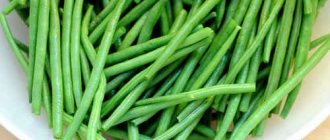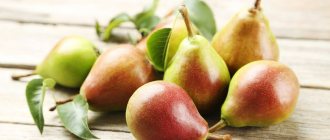Green radish is good for an aperitif, and daikon suppresses hunger. Get information about the calorie content of all types of radishes, as well as 12 dietary recipes that you can use to diversify your menu.
Author: Kristina Lobanovskaya, doctor, practicing nutritionist Article updated: 11/09/2020
Radish is a one- or two-year-old cultivated plant of the Cabbage family, considered one of the most ancient among them. Its homeland is China and Egypt. First, the familiar radish moved to Greece, then became widespread in Europe, and only then ended up in Russia. In Rus', it was valued for its medicinal qualities, while at the same time attributing effectiveness when consumed internally and externally. There are several types of root vegetables that differ in color, but this does not affect the color of the pulp in any way - it is always white. The calorie content of radish is 36 kcal per 100 grams, which allows you to include the root vegetable in the diet menu for weight loss.
Black radish - composition and calorie content
[ads2]
Radish was known to the ancient Egyptians: its properties are unique, it is able to restore strength and increase energy. The taste of the root vegetable is such that it can easily replace salt in dishes, which is very important for those following a salt-free diet. Crispy, moderately spicy - this is how it appears in dishes. But the vegetable can boast not only of taste, but also of composition, and long-term preservation of nutrients - throughout the cold period of the year.
Radish is most often eaten raw, and the body receives a lot of vitamins and other useful components:
- Thiamine
- Riboflavin
- Pantothenic acid
- Vitamins E, A, PP
- Sodium
- Potassium
- Calcium
- Iron
- Phosphorus, etc.
The calorie content of radish is low due to the high amount of fiber and minimal fat content. Fatty acids are present in small doses in the essential oils of radish, which determine its special taste and aroma. The product contains proteins, carbohydrates, glycosides, organic acids, and ash. Radish contains up to 90% water, which undoubtedly makes it light and dietary.
How many calories are in black radish?
Fresh radish is the most useful, and its nutritional value is deciphered by the following numbers:
- Proteins – 1.9 g
- Fats – 0.2 g
- Carbohydrates – 6.7 g
- Fiber and other substances – about 2 g
Application in cosmetology
This plant should not be used too often, as it is harsh on the skin. Recommended frequency: up to 3 times a week.
Before making masks, you need to cut the radish into slices and let it stand for some time in the open air. This is done to ensure that volatile compounds that can cause irritation are eliminated.
Cosmetics that are prepared from radish are given in the table:
| Means | Method of preparation and use | Impact |
| Whitening mask |
| The mask helps whiten the skin and get rid of freckles |
| Scrub for cleansing facial skin |
| The scrub helps cleanse pores and tighten them |
| Anti-dandruff remedy |
To achieve the desired effect, it is recommended to carry out 30 procedures | This mask helps get rid of dandruff and is useful for strengthening hair roots. |
Green radish - calorie content
[ads3]
A close relative of the black radish, its green “sister,” also does not leave people’s tables in our time, because it is often the most important source of vitamins and minerals, inexpensive and accessible. Green radish has almost the same composition as black radish, the differences are in the concentration of substances in essential oils. Due to the lower content of specific rare oils, the root vegetable has a less pungent taste, without bitterness. Many people do not even soak it in water before eating, and those who have a strong stomach eat the vegetable almost every day.
The calorie content of green radish is slightly lower than that of black radish - about 32 kcal. The content of basic nutrients is also similar, but proteins – 2 g, carbohydrates – 6.5 g. Green radish makes excellent vegetable salads, for example, if you season it with oil and lemon juice, and use grated apple, carrots, and fresh vegetables among other ingredients. cucumber, cabbage (Peking cabbage, white cabbage). The amount of vitamins in steamed or stewed radish will be slightly reduced, but eating it after heat treatment can safely harm your stomach.
Fresh
At first glance, radish is not very popular among modern consumers, but it remains one of the most unpretentious vegetables in the garden. No special conditions are required for cultivation - fertile soil is sufficient. In the past, attitudes towards it were different: in Egypt slaves ate it, and in Greece they gave all kinds of honors, considering it the queen of vegetables. The root vegetable has a specific taste – peppery and spicy. All thanks to the presence of glucosinolates in the composition. The spice of the plant attracts the interest of culinary specialists, who include it in snacks, salads and other dishes.
Traditional medicine has always treated the plant with respect, praising its rich biochemical composition. There are elements necessary for health (potassium, sodium, sulfur, etc.), organic acids, and vitamins. The benefits of radish have been proven in the treatment and prevention of many diseases, and freshly squeezed juice is valuable for improving the functioning of the gastrointestinal tract, preventing atherosclerosis and preventing the formation of stones in the gall bladder and kidneys. Due to its ability to lower blood sugar levels, the root vegetable is recommended for patients with diabetes, and its pronounced expectorant properties make it possible to use the vegetable in the fight against diseases of the respiratory system.
For those losing weight, the plant is seen as an equally valuable product, since it demonstrates the following properties:
- Removes toxins and waste from the body.
- Prevents constipation and fat accumulation because it contains a sufficient amount of plant fiber.
- Eliminates swelling by removing excess fluid.
- Prevents the accumulation of salts and cholesterol.
- Normalizes digestion.
Radish is classified as a low-calorie food, so its consumption while on a diet can be done without any special restrictions. It is noteworthy that in addition to the root vegetable itself, it is possible to eat leaves, flowers, pods and even seeds.
Thanks to the presence of several types, radish becomes a truly unique vegetable when planning a healthy diet. On supermarket shelves today you can find not only the black variety familiar to Russians, but also more exotic varieties.
Black
Black radish is a garden or sowing variety. It has an almost round large root vegetable with a black skin. Its inner part is juicy and dense, with a spicy aroma and taste, which is due to the content of essential oils. This species is widespread throughout Europe and North America. It contains many organic acids, enzymes, mineral salts and phytoncides. Among the obvious benefits of use are:
- normalization of the digestive system;
- strengthening the immune system;
- removing excess fluid and eliminating swelling;
- increased sweating.
Calorie content of 100 grams of pulp is 36 kcal. At the same time, it is the black radish that is the most high-calorie among its fellows, which does not at all prevent it from holding the palm in culinary affairs and folk medicine. It is often used for weight loss, since the high content of plant dietary fiber relieves hunger for a long time and prevents unhealthy snacks. Acting as a natural “scrub,” fiber frees the intestines of toxins.
The product can be consumed both fresh and as part of soups and vegetable side dishes. After eating such dishes, blood circulation improves and metabolism accelerates. The black variety goes well with vegetable and meat dishes, and can serve as a dessert in tandem with honey.
When buying such a radish, you should pay attention to its top layer, which should not be damaged or show signs of impacts, mold and rot. The vegetable should be firm to the touch. It is noteworthy that heavy root vegetables retain their bright taste and juiciness longer. You can store them in the bottom compartment of the refrigerator. In the cellar, the vegetable feels no worse and can lie until spring, maintaining a supply of useful components.
Green
The green root vegetable is the closest relative of the black one, but has a softer and more pleasant taste. It is no less often used in cooking and has a “baggage” of useful qualities. Having a pleasant green color, smoothly flowing to greenish-whitish towards the root, and a cut with snow-white pulp, the vegetable is recommended for fresh consumption, since this is how it is able to maximize its healing properties. The calorie content of green root vegetables is slightly lower than the calorie content of black root vegetables and is 32 kcal per 100 grams. During a diet for weight loss, it is recommended to include the root vegetable in fresh salads, to which it adds a slight bitterness and pronounced piquancy.
Green radish is called an excellent aperitif due to its ability to stimulate appetite and activate digestion.
The rich biochemical composition makes the root vegetable an indispensable component of proper nutrition. It has a beneficial effect on the body in general, and due to the presence of special substances in its composition, it has an antibacterial effect and stimulates the immune system. Green radish is especially useful for people with disorders of the nervous system and vision. Since the vegetable contains a high content of potassium salts, its consumption allows you to control blood pressure and improve heart function. The peel of the green product contains ascorbic acid, which not only improves health, but also has a positive effect on the condition of blood vessels. In terms of weight loss, it exhibits the following properties:
- stimulates metabolism;
- clears bile;
- removes toxins and waste;
- increases motor-evacuation function of the intestines.
Due to its fiber content, consuming vegetables seems beneficial for dysbiosis.
When choosing green radish, you should keep in mind that it will be useful only if there are no spoiled (putrefactive) places. There should be no traces of impacts or dents on it. You can store green root vegetables in the same way as black ones - in the refrigerator or cellar.
White
White radish is a plant with a thickened rhizome, colored pale green, turning white towards the end of the vegetable. It contains a record number of useful substances, especially phytoncides. The latter influence the taste of the product and provide its immunostimulating qualities. White radish is not as hot as black radish, so it is good in salads and vegetable side dishes. It is healthier to eat the vegetable fresh. Among the main qualities are:
- stimulation of appetite and improvement of digestion;
- elimination and prevention of constipation;
- treatment of atherosclerosis and cholelithiasis;
- normalization of the functioning of the stomach, kidneys and liver.
This type can be used for weight loss, since the calorie content per 100 grams is only 21 kcal. It is the white radish that is responsible for normal protein, carbohydrate and fat metabolism.
A special variety of white radish is Daikon. It is also called “big root” or “muli”. Its calorie content is similar - 21 kcal per 100 grams. The taste of Daikon is unusual, like for a radish - more delicate and not at all spicy. Another difference is the shape of the root, as Daikon is elongated and resembles a white carrot. The benefits of this variety are no less obvious: it cleanses the kidneys and liver, resists the proliferation of pathogenic bacteria, frees the body from toxins and free radicals, and improves overall health. Another advantage of Daikon, including for those losing weight, is its calming effect on the central nervous system. By consuming the product, you can instantly restore peace of mind and increase concentration.
Daikon is an ideal choice for weight loss. With a low calorie content, it does an excellent job of suppressing hunger. It also contains enzymes that help break down starch.
Daikon can be eaten raw on its own (cut, lightly salted and sprinkled with lemon juice), or included in dietary vegetable salads. The presence of root vegetables in soups seems excellent. It goes well with almost all foods: fruits, herbs, cottage cheese, cheese, boiled beef, boiled eggs. In addition to the root vegetable itself, leaves and shoots are eaten. However, it should be borne in mind that this is only possible when growing vegetables on your own plot, since the green part is stored very little.
When choosing a white product, you should be guided by already known principles: pay attention to elasticity, absence of signs of rotting and mold. Storage - in the refrigerator and cellar.
Margelanskaya
The Margelan variety is often called “Chinese” or “lobo”. It is not an independent species, but belongs to the subgroup of ordinary black radish. It is mainly grown in China, Japan, Korea and the Far East of the Russian Federation. Externally, the product is a root vegetable weighing from 200 to 500 grams. The shape can be oval, round or elongated, depending on the variety. Surprisingly, the color of the skin and even the pulp can also differ: in the first case, white, green, red and purple are found, in the second - white, greenish or red. Despite the differences, any fruit has a slightly pungent taste and is endowed with juiciness. The calorie content of the Margelan variety is 21 kcal per 100 g.
Among all types of spicy plants, Margelan is considered the most gentle for the digestive system. This is primarily due to the absence of mustard oils in the composition. However, this does not make the benefits any less. Each Margelan radish root is a storehouse of vitamins and minerals. The main value is mineral salts. Thanks to the content of fiber and pectin, people who consume them have every chance to improve the digestion process and cleanse themselves of harmful elements that clog the body.
Since the taste of the Margelan type of plant is similar to the taste of radishes, it should be used both separately in fresh form and as part of various vegetable dishes.
Red
Red radish is the most controversial product among its fellows. Some consider it a hybrid of radish and radish, others simply call it a large radish. In any case, it is usually classified as a black variety, only with bright red skin. Inside lies snow-white pulp of medium sharpness. The vegetable is quite large - about 300 grams. For every 100 grams of pulp there are 20 kcal, which makes this type the least high in calories.
Thanks to red radish, the absorption of other foods occurs several times faster.
The red vegetable is endowed with a lot of useful qualities provided by its rich biochemical composition. Thus, it has a positive effect on digestion due to the presence of coarse dietary fiber, improves appetite and removes harmful substances from the body, acting as a preventative against constipation. Due to its pronounced antibacterial properties, various intestinal diseases are prevented. Regular consumption of the vegetable helps remove excess fluid from the body, that is, relieves swelling. Another quality seems also important - help with anemia. And if you consume the red variety of the plant along with honey, you will be able to fight a cold.
It is best to consume the product fresh, adding it to salads, but it is no less useful to stew or boil, or you can also fry it. It is noteworthy that this type lends itself very well to storage. You need to choose it using the principles for determining the freshness of other types of vegetables.
Radish with butter - calories
Most of those who love this root vegetable eat radish with butter. Cooking radish with vegetable oil takes a couple of minutes, and you can use both green and black root vegetables for the dish. The procedure for creating a “masterpiece” is as follows:
- Peel and wash the radishes.
- Cut into thin circles, which are then cut into 2-4 pieces.
- Salt the vegetable slices and mash them a little with your hands to release the juice.
- Place radishes on a plate.
- Drizzle with a small amount of cold-pressed sunflower oil.
Dishes
Despite recommendations regarding the use of fresh radish, this product looks like a good component of dishes, including low-calorie ones. The best option is to include root vegetables in salads. Thanks to its specific taste, radish adds piquancy and freshness to them. Refusal of preliminary heat treatment allows you to preserve maximum benefits.
Fried in batter
Battered fried Chinese vegetable is a delicious appetizer that comes together very quickly. Thanks to the crispy “breading”, it is possible to preserve all the beneficial properties of the product and its juiciness. The dish is not too high in calories - there are about 160 kcal per 100 grams.
To prepare the appetizer, take a 200-gram vegetable root, wash it and peel off the outer skin. The pulp is cut into circles, no more than 0.5 cm thick, and then each circle is divided in half. Lightly add salt and set aside. Prepare the batter: beat a chicken egg with a little salt and chopped herbs. Each semicircle is dipped in flour (if the recipe is used for weight loss, instead of the usual wheat, you can choose less high-calorie flour - oatmeal or flaxseed), and then in an egg. Before frying, dip in flour again. Place each slice on a heated frying pan greased with olive oil. Fry over medium heat until golden brown (on each side). The finished dish goes well with low-fat sour cream.
With butter
Spicy pulp with butter and salt is the simplest snack recommended for the diet of those losing weight. It’s not worth cooking for future use, since you won’t be able to eat much due to the specific taste. But the caloric content is pleasing - only 74 kcal per 100 g.
For preparation, take 200 grams of juicy pulp. Cut into thin slices and place on a plate. Lightly add salt and crush to release the juice. Add a tablespoon of vegetable oil (if you are losing weight, you should choose cold-pressed olive oil).
Typically, black radish is suitable for this recipe, but you can use any type of plant if you wish.
With sour cream
A fragrant root vegetable seasoned with a dairy product - a simple salad served for lunch and dinner. The calorie content of radish with sour cream is 111 kcal per 100 g, but in many respects everything depends on the percentage of fat content of sour cream: the lower it is, the more useful the salad will be for those on a diet.
Cooking the dish does not require much time. 200 grams of green or black radish, peeled, grated on a fine grater and lightly seasoned. Cover the container with the workpiece with a lid and shake well. Before serving, add a teaspoon of sour cream and stir.
With mayonnaise
Fresh Daikon with mayonnaise is a delicious combination. The dish is a good option for the lunch menu. Since store-bought mayonnaise contains too many harmful additives, you should use homemade mayonnaise for preparation. In this case, the calorie content of 100 grams of the dish will be equal to only 29 kcal, which makes it recommended even during periods of limited nutrition. Preparing the snack is simple: 200 grams of chopped Daikon pulp are mixed with 0.5 teaspoon of homemade mayonnaise.
Salad "Brush"
The usual “Brush” salad for deep cleansing the body of toxins includes carrots, white cabbage and beets. Its modified version, endowed with no less efficiency, contains black radish. It replaces cabbage. Calorie content per 100 g of dish is 67 kcal.
To prepare the salad, take one part of carrots, a quarter of radishes, and one part of beets. Grind on a grater, mix with one chopped clove of garlic and a pinch of herbs (dill, cilantro, parsley, green onions). Before serving, sprinkle with a small amount of freshly squeezed lemon juice.
Salad with cabbage
One of the best salads for simultaneously losing weight and cleansing the body is a salad with black root vegetables and red cabbage. 100 g of the dish contains no more than 51 kcal, while it is perfectly filling and easy to prepare.
For several servings you need 250 g of red cabbage and 100 g of black vegetable. They are prepared and chopped. Place on a plate and add a little salt, then knead with your hands. Add 1 teaspoon of vegetable oil and mix thoroughly. Before serving, sprinkle with fresh herbs. This salad looks like a good option not only for lunch, but will also be a light snack in the evening.
Eating salad as part of the diet allows us to talk about the normalization of cholesterol levels in the blood and the functioning of all organs of the digestive system.
Salad with pickled cucumber
A spicy salad of black root vegetables and pickled cucumber is low in calories: 100 grams contains about 63 kcal. To prepare it, you need to chop one radish root and 2 medium-sized pickled cucumbers. Place the ingredients in a container and pour in a tablespoon of vegetable oil. Sprinkle with 2 grams of black pepper and use salt to taste.
Many people mistakenly believe that including pickles in a salad makes the dish less healthy. In fact, the product contains numerous microorganisms that control the development of harmful bacteria. Additionally, pickles help control blood pressure.
Chicken salad
The salad, with a calorie content of 89 kcal per 100 g, is made from green radish, although if you wish, you can change the classic recipe and use a vegetable of a different color. Thanks to the inclusion of chicken meat in the dish, it becomes an indispensable source of proteins and important amino acids.
To prepare a dietary salad, take 150 g of onions (cut into half rings), 120 g of fresh carrots (shredded), 150 g of green radish (shredded). Vegetable ingredients are mixed. 140 g of boiled chicken fillet is cut into small cubes and added to the vegetables. Dress the salad with homemade mayonnaise (if desired, you can replace it with low-fat sour cream). Add salt as needed. This salad can be a good alternative to high-calorie dishes eaten for dinner.
Salad with celery
A salad with the addition of celery looks truly useful in the diet of those losing weight. The famous negative-calorie vegetable pairs well with the savory root vegetable. The best choice seems to be using white radish. Additionally, greens are added to the salad, which are a source of all kinds of vitamins, and fresh garlic, which accelerates metabolism. The calorie content of 100 g of salad is 45 kcal, so you can consume it without restrictions.
To prepare several servings, take 360 g of celery root, 200 g of white radish root, 80 g of onions, 5 g of garlic and 25 g of green onion. The ingredients are crushed at your discretion. After mixing, pour them with a teaspoon of vegetable oil.
The optimal time to consume a dietary fat-burning and cleansing dish is considered to be lunch, but if desired, you can treat yourself to it even in the morning.
Lentil soup
The soup, equally healthy and tasty hot or cold, involves the use of ordinary garden radish, that is, black. The dish is recommended for dietary nutrition because it is low in calories: 135 kcal per 100 g.
100 g of green lentils are soaked in water for a couple of hours to swell. Afterwards, the water is drained, filled with new water in the amount of 600 ml and brought to a boil. Add 100 g of diced root pulp and one chopped bell pepper. After boiling, boil for 5 to 8 minutes. Salt and pepper are added to taste. Before serving, the soup should steep for 1 hour. Then you can sprinkle it with chopped parsley.
Soup with cabbage
The first dish with the addition of garden root vegetables and white cabbage has a minimal calorie content - 16 kcal per 100 grams - and is excellent for consumption during weight loss. The vitamin composition of the soup is also excellent, so that along with losing weight, you can achieve overall health improvement for the body.
200 g of spicy pulp is cut into small cubes and lightly fried in olive oil. Allow to simmer for 5-7 minutes. At the same time, prepare the frying: place a chopped onion and half of the grated carrots in a frying pan and fry in olive oil. Four cloves of garlic, pre-chopped, and a tablespoon of tomato paste are added to the frying. Simmer for 5 minutes. Place all the preparations into a pan of boiling water, add spices and add a little salt. Boil the soup for 30 minutes. Five minutes before the end of cooking, add chopped herbs.
Okroshka
Okroshka with the addition of Daikon is a winter version of a popular dish among Russians. The root vegetable easily replaces radishes, so okroshka turns out to be appetizing, and also low in calories - only 60 kcal per 100 g. It is convenient to prepare for future use and use it as lunch or dinner during a diet.
For 6 servings you need one Daikon, five boiled potatoes in their jackets, one fresh cucumber, 200 g of Adyghe cheese. By the way, it is Adyghe cheese that replaces sausage and eggs in the dish, thereby significantly reducing its calorie content.
The finished potatoes are peeled and cut into cubes. Do the same with cucumber, Daikon and Adyghe cheese. Place the ingredients in a container and add fresh herbs. The dressing is a mixture of mineral water, low-fat sour cream and mustard. If desired, you can add a little ground black pepper and black salt.
Dietary properties of radish
Radish, the calorie content of which we will consider in our article today, like most other vegetables, is a product with low energy value. It is this quality that determines the interest in radish for those of us who are struggling with excess body weight or are simply trying to monitor their weight. So, let's remember how radish can be useful for us.
Radish is, one can say without exaggeration, a unique product for those who would like to improve their health. The roots of this garden crop are a rich source of various mineral components.
They contain an average of 13% dry matter, a number of vitamins, for example, C, B1, B2, as well as a number of organic acids, essential oils and glucosides. Due to its specific taste, radish is widely used as an ingredient in many dishes (for example, in preparing salads).
The composition of its root vegetables is rich and varied - up to 90% water, sugar, fiber, sulfur-containing substances that determine its phytoncidal and bactericidal effect, acids, compounds of sodium, potassium, calcium, magnesium, phosphorus, iron, and a number of amino acids.
Thanks to such a wonderful composition, radish is especially useful in winter and early spring, as it helps the body cope with a deficiency of vitamins and minerals. Radish has a strong destructive effect on pathogens.
Radish stimulates appetite, enhances the secretion of gastric juice, and has a diuretic and choleretic effect. The fiber in its composition helps remove excess cholesterol from the body, which is essential in the prevention of atherosclerosis. Radish (especially juice) has a diuretic effect and is useful for kidney stones.
During the research, it was found that radish fruits have the following composition (per 100 grams of pure product): 88 grams of water, 1.9 grams of proteins, 0.2 grams of fat, 8.1 grams of carbohydrates. We do not list the rest of the composition. Based on these data, it is concluded that:
The average calorie content of radish is 30 kcal per 100 grams of product. Which makes it a wonderful component in any diet.
What is the calorie content of radish, different varieties? And here it is:
In folk medicine
The use of radish is quite wide: for example, its juice is used to normalize intestinal function and generally help the digestive system, and women use it to strengthen hair. Regular use of radish helps in the prevention of vascular atherosclerosis, as it cleanses the body and promotes the normal functioning of the cardiovascular system [6]. In addition, it perfectly helps fight swelling, especially if it occurs very often. Radish is also prescribed by doctors for those who suffer from stones in the urinary or gall bladder.
Radish is also known as an excellent way to treat radiculitis, for which a compress is made from it on the sore spot. Radish is considered an excellent way to keep the body in good shape, because it stimulates digestion, improves metabolism, helps produce more gastric juice and bile for the normal digestion process [7].
It is believed that radish is excellent for various diseases of the upper respiratory tract, including cough. In this case, you need to grate fresh radish and take it with honey to remove phlegm and improve the patient’s condition.
Radish recipes
What can you prepare from this vegetable at home? Yes, a lot! Here is one of the recipes:
Radish salad
Products
- Tomatoes - 6 pieces
- Radish - 1 piece
- Onion - 1 piece
- Vegetable oil - 4 tablespoons
- Salt - to taste
The radish is pre-peeled. Then the radish is grated on a coarse grater. Tomatoes need to be cut into slices, then combined with radish. Add salt, chopped onions and vegetable oil. Mix all ingredients. Before serving, the finished salad can be decorated with a sprig of any greenery - your choice. That's all! Eat for your health, especially since the low calorie content of radishes will definitely not spoil your figure.
Dried
Dried radish is no less popular seasoning than garlic or hot pepper. It can be used in the preparation of first and second courses, adding a special aroma and spice. In principle, you can buy a ready-made product in stores, but it is much healthier, especially when losing weight, to use your own seasoning. This contains the full range of benefits inherent in fresh vegetables: vitamins, macro- and microelements, unsaturated fatty acids.
If you wish, you can dry any type of plant, but black seems to be the most suitable for this. To begin with, the root is thoroughly washed and peeled, then cut into thin slices and laid out in one layer on a flat surface. Keep it outdoors away from sunlight for several days, and then put it in the oven. The required temperature is 60 degrees.
It’s just as easy to dry root vegetables in an electric dryer. In this case, no preparatory stage is required. The pulp is cut into thin slices and kept in a household appliance at a temperature of 60 degrees for 6 to 18 hours.
The finished product can be used in the form of slices or crushed using a coffee grinder. The seasoning should be stored in a glass container with a tight-fitting lid away from the sun and moisture.
The calorie content of the dried product is 271 kcal per 100 grams. The increase in calorie content in comparison with fresh root vegetables occurs due to the evaporation of moisture during the drying process and an increase in the amount of carbohydrates.
What are the benefits of radish for weight loss?
What are the benefits of radish for those who want to lose weight? Here's what:
The presence of a large amount of fiber helps cleanse the intestines of waste and toxins, which makes the skin fresher, the stomach flatter, and the indicator on the scale reduced.
The lack of fat and minimal calorie content will certainly not lead to weight gain, so eat radish often (but taking into account contraindications).
Radish minerals support normal water-salt metabolism, as a result of which swelling quickly goes away, weight decreases, as does body volume.
Radish prevents fat, cholesterol, and salt deposits from accumulating, which also makes the appearance more attractive.
Radish enzymes and its pungent esters help improve digestion and quickly digest and assimilate heavy foods. Extra pounds will not accumulate when radishes are combined with meat and other high-calorie foods.
After eating radish, metabolism accelerates, which cannot but contribute to slimness (especially in combination with sports).
Radish has a very low calorie content and can be easily added to light vegetable salads. However, this should be done with caution, since the enzymes in its composition stimulate the appetite and instead of one serving of the dish, you can easily eat two. Depending on the desired result, recipes containing radish also change.
Harm and contraindications
Excessive consumption of radish may cause severe burning in the stomach and flatulence, as well as possible cardiac dysfunction.
Consumption of vegetables is contraindicated in the following cases:
- individual intolerance;
- stomach diseases (ulcers, gastritis);
- colitis;
- pancreatic diseases;
- gout;
- liver and kidney diseases;
- gallstones.
If contraindications are ignored, the harm from eating vegetables manifests itself in the exacerbation of these pathologies.
Even in the absence of serious diseases, before using radish for medicinal purposes, you should consult a doctor.
Interesting facts about radish
- Radish was originally cultivated in Ancient Egypt, after which it was actively grown in Ancient Greece, where it became a staple food.
- In Egypt, radish, along with garlic and onions, was the only root vegetable available to slaves and workers. This is indicated on the corresponding inscription found in the Cheops pyramid.
- The root vegetable first appeared in China and Japan, and was actively used not only in cooking, but also as an effective medicine.
- The well-known radish is considered a variety of radish.
- Green radish is a biennial crop. In the first year, roots are obtained, in the second - seeds.
- Radish is the most popular root vegetable, found in proverbs and sayings: “it’s worse than bitter radish”, “horseradish is not sweeter than radish”.
Benefit
First of all, it is worth noting the enormous benefits of radish for the gastrointestinal tract and digestive system. Radish contains substances and microelements necessary for normal fermentation . The fibers of this root vegetable help remove toxins from the body. Also, this product is low-calorie, which makes it an excellent component for any diet menu aimed at losing weight.
Diabetics can also eat radish due to its positive lowering effect on blood sugar levels. Carotene and retinol in radish help improve vision and strengthen bone and muscle tissue.
One cannot ignore the fact that radish is used in various traditional medicine recipes for the treatment of:
- gout;
- cough;
- swelling;
- intestinal dysfunctions, etc.
Women can use various cosmetic masks based on this miraculous root vegetable.
Read our materials about the benefits and harms of green radish, as well as about growing the vegetable.
Radish in cooking
From a culinary point of view, oddly enough, you can make anything from radish, not just bitter salads. During the existence of radish, they learned to prepare turya (a Lenten stew popular in Ancient Rus'), all kinds of soups, side dishes for meat, poultry and even squid, as well as several dozen salads. In addition, some craftsmen also prepare sandwiches with cheese and tomatoes from radishes.
It is important to understand that the maximum benefit can be “squeezed out” exclusively from raw radish. It’s true that you won’t be able to eat a lot of it. But lightly cooked or steamed radishes are perceived by the taste buds and the body as “Hurray!” and at the same time retains quite a lot of useful substances. Therefore, do not focus on the benefits of the raw product. Better make it not only healthy, but also tasty. And we will help you with this!
Why is it important to know the ingredients of a product?
By becoming familiar with the vitamins and minerals contained in a product, you can learn about its benefits for the body. This allows you to correctly create a daily menu, providing yourself with all the necessary nutrients. A balanced diet is especially important for people suffering from chronic diseases. They need to know the calorie content, the ratio of proteins, fats and carbohydrates of a vegetable crop.
Radish brings both benefits and harm to the body. Therefore, you should familiarize yourself with the contraindications to the herbal product and possible side effects.
Why is it important to know the composition of a vegetable?
The composition of any product is the most important information about its usefulness and harmfulness. The existing vitamins and elements of radish have a certain effect on the functioning of the human body. This impact can be both positive and negative. Therefore, you need to know about the properties of radish, what vitamins, how many calories and nutritional supplements it contains, in order to use them to improve the functioning of your body.
The use of certain substances in the presence of illnesses has its contraindications. Before consuming a vegetable in large quantities, you need to familiarize yourself with its composition.
What to prepare for future use?
Sometimes there is no place to store the harvest. Good news: radishes are suitable for home preparation!
Radish appetizer
Ingredients: black radish - 400 g, sweet pepper - 100 g, carrots - 100 g, dill - 50 g, garlic - 4-5 cloves, sugar and salt - 1 tbsp. spoon without top, vinegar 9% - 40 g.
Preparation: Peel the radish and grate it on a coarse grater. Add chopped garlic and herbs. Cut the pepper into strips, grate the carrots coarsely. Boil the peppers and carrots for 5 minutes, add to the radishes, add salt, sugar and vinegar and stir. Place in sterilized jars and pour boiling water until it barely covers the vegetables. Pasteurize 0.5 liter jars for 10 minutes, liter jars for 15 minutes. Roll up, turn over and put under blanket until cool.
Photo: Shutterstock.com/ Adi Ciurea










